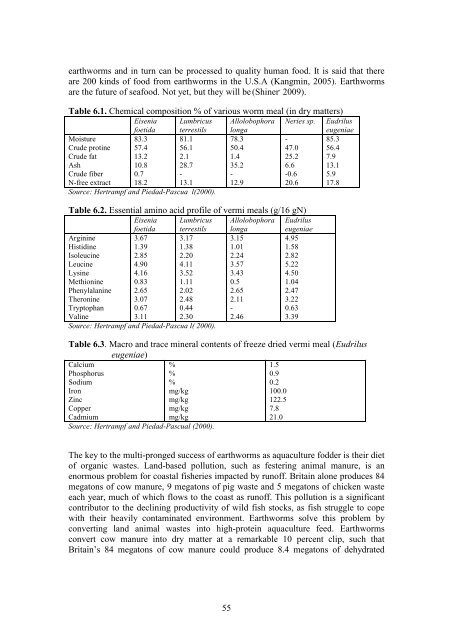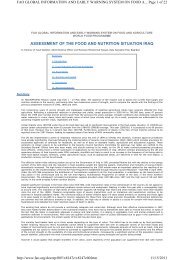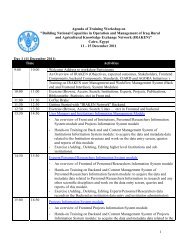Vermiculture in Egypt: - FAO - Regional Office for the Near East and
Vermiculture in Egypt: - FAO - Regional Office for the Near East and
Vermiculture in Egypt: - FAO - Regional Office for the Near East and
You also want an ePaper? Increase the reach of your titles
YUMPU automatically turns print PDFs into web optimized ePapers that Google loves.
earthworms <strong>and</strong> <strong>in</strong> turn can be processed to quality human food. It is said that <strong>the</strong>re<br />
are 200 k<strong>in</strong>ds of food from earthworms <strong>in</strong> <strong>the</strong> U.S.A (Kangm<strong>in</strong>, 2005). Earthworms<br />
are <strong>the</strong> future of seafood. Not yet, but <strong>the</strong>y will be (Sh<strong>in</strong>er , 2009).<br />
Table 6.1. Chemical composition % of various worm meal (<strong>in</strong> dry matters)<br />
Eisenia Lumbricus<br />
foetida terrestils<br />
Moisture<br />
83.3 81.1<br />
Crude prot<strong>in</strong>e 57.4 56.1<br />
Crude fat 13.2 2.1<br />
Ash<br />
10.8 28.7<br />
Crude fiber 0.7 -<br />
N-free extract 18.2 13.1<br />
Source: Hertrampf <strong>and</strong> Piedad-Pascua l(2000).<br />
55<br />
Allolobophora<br />
longa<br />
78.3<br />
50.4<br />
1.4<br />
35.2<br />
-<br />
12.9<br />
Table 6.2. Essential am<strong>in</strong>o acid profile of vermi meals (g/16 gN)<br />
Eisenia Lumbricus<br />
foetida terrestils<br />
Arg<strong>in</strong><strong>in</strong>e<br />
3.67 3.17<br />
Histid<strong>in</strong>e<br />
1.39 1.38<br />
Isoleuc<strong>in</strong>e 2.85 2.20<br />
Leuc<strong>in</strong>e<br />
4.90 4.11<br />
Lys<strong>in</strong>e<br />
4.16 3.52<br />
Methion<strong>in</strong>e 0.83 1.11<br />
Phenylalan<strong>in</strong>e 2.65 2.02<br />
Theron<strong>in</strong>e 3.07 2.48<br />
Tryptophan 0.67 0.44<br />
Val<strong>in</strong>e<br />
3.11 2.30<br />
Source: Hertrampf <strong>and</strong> Piedad-Pascua l( 2000).<br />
Allolobophora<br />
longa<br />
3.15<br />
1.01<br />
2.24<br />
3.57<br />
3.43<br />
0.5<br />
2.65<br />
2.11<br />
-<br />
2.46<br />
Neries sp. Eudrilus<br />
eugeniae<br />
-<br />
85.3<br />
47.0 56.4<br />
25.2 7.9<br />
6.6 13.1<br />
-0.6 5.9<br />
20.6 17.8<br />
Eudrilus<br />
eugeniae<br />
4.95<br />
1.58<br />
2.82<br />
5.22<br />
4.50<br />
1.04<br />
2.47<br />
3.22<br />
0.63<br />
3.39<br />
Table 6.3. Macro <strong>and</strong> trace m<strong>in</strong>eral contents of freeze dried vermi meal (Eudrilus<br />
eugeniae)<br />
Calcium<br />
Phosphorus<br />
Sodium<br />
Iron<br />
Z<strong>in</strong>c<br />
Copper<br />
Cadmium<br />
%<br />
%<br />
%<br />
mg/kg<br />
mg/kg<br />
mg/kg<br />
mg/kg<br />
Source: Hertrampf <strong>and</strong> Piedad-Pascual (2000).<br />
1.5<br />
0.9<br />
0.2<br />
100.0<br />
122.5<br />
7.8<br />
21.0<br />
The key to <strong>the</strong> multi-pronged success of earthworms as aquaculture fodder is <strong>the</strong>ir diet<br />
of organic wastes. L<strong>and</strong>-based pollution, such as fester<strong>in</strong>g animal manure, is an<br />
enormous problem <strong>for</strong> coastal fisheries impacted by runoff. Brita<strong>in</strong> alone produces 84<br />
megatons of cow manure, 9 megatons of pig waste <strong>and</strong> 5 megatons of chicken waste<br />
each year, much of which flows to <strong>the</strong> coast as runoff. This pollution is a significant<br />
contributor to <strong>the</strong> decl<strong>in</strong><strong>in</strong>g productivity of wild fish stocks, as fish struggle to cope<br />
with <strong>the</strong>ir heavily contam<strong>in</strong>ated environment. Earthworms solve this problem by<br />
convert<strong>in</strong>g l<strong>and</strong> animal wastes <strong>in</strong>to high-prote<strong>in</strong> aquaculture feed. Earthworms<br />
convert cow manure <strong>in</strong>to dry matter at a remarkable 10 percent clip, such that<br />
Brita<strong>in</strong>‟s 84 megatons of cow manure could produce 8.4 megatons of dehydrated





